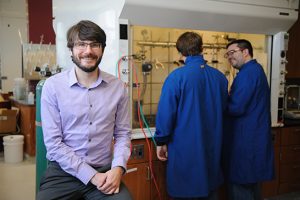From the January 2018 Desktop News | Dr. Jared Allred, assistant professor of chemistry at The University of Alabama, was recently awarded a grant from the 2017 Early Career Research Program sponsored by the U.S. Department of Energy to investigate properties of novel metal compounds and develop a new way to analyze certain aspects of these materials.

“Anytime you are working on new materials, you need to be able to understand the physics of what’s going on – the interactions,” Allred said. “Understanding those interactions at a fundamental level will help us down the road to improve their application to technology. Before you put these materials in devices, you need to understand them.”
Allred’s project is one of 59 proposals selected for funding from more than 700 submissions to the energy department. Formally called “Investigation of Short-Range Ordering in Transition Metal Compounds by Diffuse Scattering,” the project will receive $750,000 over five years from the Office of Basic Energy Science and the department’s EPSCOR program.
Allred joined the University in August 2015 after working three years on a postdoctoral appointment at Argonne National Laboratory near Chicago. The grant will fund student research assistants, experimental materials, and travel to Argonne and Oak Ridge National Labs to run several experiments.
New materials with unique properties are needed to meet the future demands of energy production, data storage, and microelectronics. Scientists create new metal compounds with tunable properties, but often do not understand how they work at the atomic level, limiting their application.
“Like a lot of solid-state chemists, I’m interested in the correlation between structure and the actual properties we can measure,” he said. “In this work, I will be focusing on specific examples where this connection is not fully understood. In these cases, drastic changes in properties are induced by nearly imperceptible changes in the chemical structure. This is what I hope to uncover.”
Allred and his students will create new compounds at UA by tinkering with the atoms and then measure the tiny deviations of the compounds’ structure to learn about their characteristics. This process, called diffuse scattering, examines the background signal from a standard x-ray or neutron diffraction experiment that show the average structure of the material. Diffuse scattering shows the atomic interactions that behave differently from the average.
The project not only sets out to understand novel and newly-modified known compounds, but Allred wants to improve upon existing methods for analyzing the massive amounts of data created through diffuse scattering. Allred hopes to simplify the data, which is generated as three-dimensional images, by mapping it onto the underlying symmetry that atoms naturally follow.
This will be helpful for keying in on the behavior relevant to an application such as computer memory or electric transmission.
To accomplish all this, Allred will cooperate with other scientists located at national laboratories, such as Argonne and Oak Ridge, that specialize in different aspects of the measurement or interpretation of diffuse scattering.
“I think all of us are interested in improving the tools, with the interpretation of the data being only one of several challenges,” Allred said.
By reducing the size of the information to sort through, Allred wants to create an adaptable tool useful for scientists trying to understand a diverse range of materials.
“The end result is, hopefully, to gets lots of people doing this on the materials they are interested in,” he said. “I don’t want it to be a niche technique. It would be great if there are lots of people who are confident they can do it.”